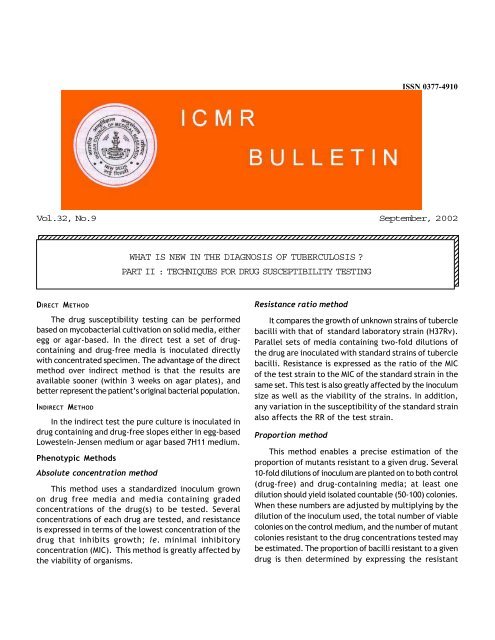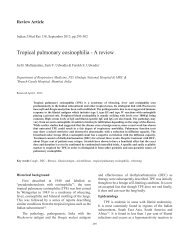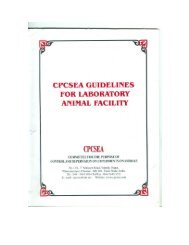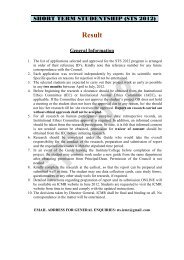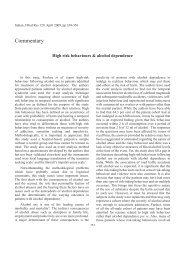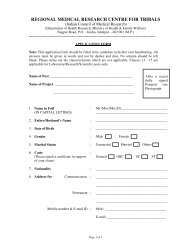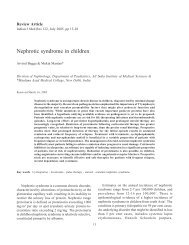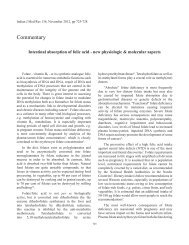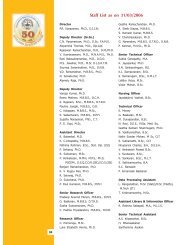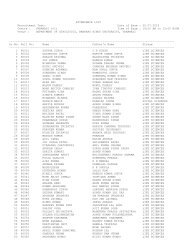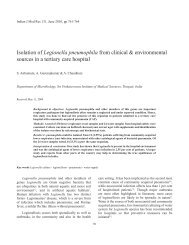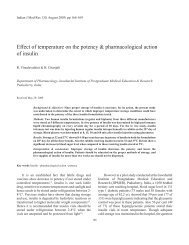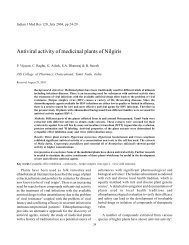September, 2002 - Indian Council of Medical Research
September, 2002 - Indian Council of Medical Research
September, 2002 - Indian Council of Medical Research
Create successful ePaper yourself
Turn your PDF publications into a flip-book with our unique Google optimized e-Paper software.
ISSN 0377-4910<br />
Vol.32, No.9 <strong>September</strong>, <strong>2002</strong><br />
123456789012345678901234567890121234567890123456789012345678901212345678901234567890123456789012123<br />
123456789012345678901234567890121234567890123456789012345678901212345678901234567890123456789012123<br />
WHAT IS NEW IN THE DIAGNOSIS OF TUBERCULOSIS ?<br />
PART II : TECHNIQUES FOR DRUG SUSCEPTIBILITY TESTING<br />
123456789012345678901234567890121234567890123456789012345678901212345678901234567890123456789012123<br />
123456789012345678901234567890121234567890123456789012345678901212345678901234567890123456789012123<br />
123456789012345678901234567890121234567890123456789012345678901212345678901234567890123456789012123<br />
123456789012345678901234567890121234567890123456789012345678901212345678901234567890123456789012123<br />
123456789012345678901234567890121234567890123456789012345678901212345678901234567890123456789012123<br />
123456789012345678901234567890121234567890123456789012345678901212345678901234567890123456789012123<br />
123456789012345678901234567890121234567890123456789012345678901212345678901234567890123456789012123<br />
123456789012345678901234567890121234567890123456789012345678901212345678901234567890123456789012123<br />
123456789012345678901234567890121234567890123456789012345678901212345678901234567890123456789012123<br />
123456789012345678901234567890121234567890123456789012345678901212345678901234567890123456789012123<br />
123456789012345678901234567890121234567890123456789012345678901212345678901234567890123456789012123<br />
DIRECT METHOD<br />
The drug susceptibility testing can be performed<br />
based on mycobacterial cultivation on solid media, either<br />
egg or agar-based. In the direct test a set <strong>of</strong> drugcontaining<br />
and drug-free media is inoculated directly<br />
with concentrated specimen. The advantage <strong>of</strong> the direct<br />
method over indirect method is that the results are<br />
available sooner (within 3 weeks on agar plates), and<br />
better represent the patient’s original bacterial population.<br />
INDIRECT METHOD<br />
In the indirect test the pure culture is inoculated in<br />
drug containing and drug-free slopes either in egg-based<br />
Lowestein-Jensen medium or agar based 7H11 medium.<br />
Phenotypic Methods<br />
Absolute concentration method<br />
This method uses a standardized inoculum grown<br />
on drug free media and media containing graded<br />
concentrations <strong>of</strong> the drug(s) to be tested. Several<br />
concentrations <strong>of</strong> each drug are tested, and resistance<br />
is expressed in terms <strong>of</strong> the lowest concentration <strong>of</strong> the<br />
drug that inhibits growth; ie. minimal inhibitory<br />
concentration (MIC). This method is greatly affected by<br />
the viability <strong>of</strong> organisms.<br />
Resistance ratio method<br />
It compares the growth <strong>of</strong> unknown strains <strong>of</strong> tubercle<br />
bacilli with that <strong>of</strong> standard laboratory strain (H37Rv).<br />
Parallel sets <strong>of</strong> media containing two-fold dilutions <strong>of</strong><br />
the drug are inoculated with standard strains <strong>of</strong> tubercle<br />
bacilli. Resistance is expressed as the ratio <strong>of</strong> the MIC<br />
<strong>of</strong> the test strain to the MIC <strong>of</strong> the standard strain in the<br />
same set. This test is also greatly affected by the inoculum<br />
size as well as the viability <strong>of</strong> the strains. In addition,<br />
any variation in the susceptibility <strong>of</strong> the standard strain<br />
also affects the RR <strong>of</strong> the test strain.<br />
Proportion method<br />
This method enables a precise estimation <strong>of</strong> the<br />
proportion <strong>of</strong> mutants resistant to a given drug. Several<br />
10-fold dilutions <strong>of</strong> inoculum are planted on to both control<br />
(drug-free) and drug-containing media; at least one<br />
dilution should yield isolated countable (50-100) colonies.<br />
When these numbers are adjusted by multiplying by the<br />
dilution <strong>of</strong> the inoculum used, the total number <strong>of</strong> viable<br />
colonies on the control medium, and the number <strong>of</strong> mutant<br />
colonies resistant to the drug concentrations tested may<br />
be estimated. The proportion <strong>of</strong> bacilli resistant to a given<br />
drug is then determined by expressing the resistant
portion as a percentage <strong>of</strong> the total population used.<br />
The proportion method is currently the method <strong>of</strong> choice<br />
for estimating drug resistance and this principle is being<br />
applied to the following rapid testing methods.<br />
(i) BACTEC 460 (irst and second line);<br />
(ii) MGIT 960;<br />
(iii) MB/BacT system; and<br />
(iv) ESP II system<br />
Recently Developed Phenotypic Methods<br />
E -test (Commercially available as AB BIODISK)<br />
It is based on determination <strong>of</strong> drug susceptibility using<br />
strips containing gradients <strong>of</strong> impregnated antibiotics. There<br />
are reports about a high rate <strong>of</strong> false resistance by this<br />
method when compared with BACTEC or conventional<br />
LJ proportion methods1 .<br />
Micro well alamar blue assay and micro plate tetrazolium<br />
reduction assay<br />
The above tests are colorimetric based on the<br />
oxidation-reduction <strong>of</strong> the dye Alamar blue or MTT 3-(4,5dimethylthiazol-2-yl)-2,5-diphenyl<br />
tetrazolium bromide).<br />
Drug resistance is detected by the reduction <strong>of</strong> the dye<br />
from blue to pink due the oxidation-reduction metabolism<br />
<strong>of</strong> viable organisms2-3 .<br />
Mycolic acid index susceptibility testing<br />
This is a modification <strong>of</strong> the original mycolic acid<br />
analysis by HPLC where a coumarin compound is used<br />
as a fluorescent derivatizing agent <strong>of</strong> mycolic acid instead<br />
<strong>of</strong> p-bromophenacyl bromide. The drug sensitivity is<br />
assessed by measuring the total area under mycolic acid<br />
(TAMA) chromatographic peaks <strong>of</strong> a culture <strong>of</strong><br />
M.tuberculosis, and this area has a very good correlation<br />
with log CU per milliliter. Depending on the signal and<br />
quantification <strong>of</strong> this procedure, drug susceptibility pattern<br />
can be carried out as a rapid method4 .<br />
Microscopic observation <strong>of</strong> broth cultures – Drug<br />
susceptibility assay<br />
This novel method <strong>of</strong> microscopic observation <strong>of</strong> broth<br />
cultures with drugs is used for drug sensitivity testing. It<br />
is a relatively inexpensive and fairly rapid drug susceptibility<br />
testing method with a high sensitivity and specificity and<br />
is suited for disease endemic developing countries5 .<br />
Micro colony detection<br />
This employs observation <strong>of</strong> micro-colonies <strong>of</strong><br />
M.tuberculosis with the help <strong>of</strong> a microscope, on a thin<br />
layer <strong>of</strong> 7H11 agar plate and is used for drug sensitivity<br />
testing. It is less expensive than the conventional<br />
proportion method, and may be a good low-cost<br />
alternative for resource poor countries 6 .<br />
Pha B assay<br />
This is a new phenotypic culture drug susceptibility<br />
testing method named as phage amplified biologically<br />
(Pha B), and is based on the ability <strong>of</strong> viable M.tuberculosis<br />
to support the replication <strong>of</strong> an infecting mycobacteriophage;<br />
non-infecting exogenous phages are<br />
inactivated by chemical treatment. The number <strong>of</strong><br />
endogenous phages, which is an indication <strong>of</strong> the original<br />
number <strong>of</strong> viable M.tuberculosis, is determined after cycles<br />
<strong>of</strong> infection, replication and release in rapidly growing<br />
mycobacteria. In the case <strong>of</strong> drug-resistant M.tuberculosis,<br />
bacilli will remain viable and protect the mycobacteriophage.<br />
Any mycobacteriophage protected within<br />
viable bacilli replicate and ultimately lyse their host. or<br />
rapid detection, the released mycobacteriophages are<br />
mixed with rapidly growing M.smegmatis host in which<br />
they undergo rapid cycle <strong>of</strong> infection, replication and lysis.<br />
Lysis is easily seen as clear areas or plaques in a lawn<br />
culture <strong>of</strong> M.smegmatis. The number <strong>of</strong> plaques generated<br />
from a given sample is directly proportional to the number<br />
<strong>of</strong> protected mycobacteriophages, which is dependent<br />
on the number <strong>of</strong> tubercle bacilli that remain viable after<br />
drug treatment (ie. drug-resistant). Gingeras et al 7 reported<br />
successful application <strong>of</strong> this assay.<br />
Luciferase reporter phage assay<br />
In this technique, viable mycobacteria are infected<br />
with reporter phages expressing firefly luciferase gene.<br />
Easily detectable signals are seen a few minutes after<br />
the infection <strong>of</strong> M.tuberculosis with reporter phages. Light<br />
production requires metabolically active M.tuberculosis<br />
cells, in which reporter phages replicate and luciferase<br />
gene is expressed. When drug-susceptible M.tuberculosis<br />
strains are incubated with specific anti-tuberculosis drugs,<br />
they fail to produce light after infection with luciferase<br />
reporter phages. In contrast, drug-resistant strains are<br />
unaffected by the drugs and produce light at levels<br />
equivalent to those documented for untreated controls<br />
after infection with reporter phages 8 . The other reporter<br />
molecule described is the green fluorescence protein (GP)<br />
<strong>of</strong> the jellyfish Aequorea victoria. This reporter system does<br />
not require c<strong>of</strong>actors or substances due to intrinsic<br />
fluorescence nature <strong>of</strong> the GP 9 . These tests have generally<br />
good sensitivity and reproducibility but are yet to be used<br />
in routine clinical laboratories.
Genotypic Methods<br />
These are essentially required for the rapid<br />
identification <strong>of</strong> multi drug resistant (MDR) TB strains.<br />
In contrast to other bacteria, drug resistance in<br />
M.tuberculosis is not plasmid mediated. Most <strong>of</strong> the<br />
molecular events relating to the chromosomal basis <strong>of</strong><br />
drug resistance have been elucidated. The phrase “MDR<br />
state” in mycobacteriology refers to simultaneous<br />
resistance to at least rifampicin and INH (with or without<br />
resistance to other drugs). Genetic and molecular analysis<br />
<strong>of</strong> drug resistance in MDR TB suggests, that the bacilli<br />
usually acquire resistance either by alteration <strong>of</strong> the drug<br />
target by mutation or by titration <strong>of</strong> the drug through<br />
over-production <strong>of</strong> the target. The MDR TB usually results<br />
from accumulation <strong>of</strong> individual target genes 10 . The list<br />
<strong>of</strong> various gene loci conferring resistance in<br />
M. tuberculosis are listed below in table.<br />
Table. Various gene loci conferring drug resistance in<br />
M. tuberculous<br />
Drug Gene Gene product/ Cellular<br />
unctional role farget<br />
Rifampicin rpoB B sub-unit <strong>of</strong> RNA Nucleic acids<br />
polymerase/<br />
transcription<br />
Isoniazid KatG Catalase-peroxidase/<br />
Activation <strong>of</strong> pro-drug<br />
Cell wall<br />
OxyR-ahpC alkyl-hydro-reductase<br />
Kas A b-ketoacyl acyl carrier<br />
protein<br />
INH- inhA Enoyl-ACP reductase/ Cell wall<br />
Ethionamide Synthase;<br />
Mycolic acid<br />
biosynthesis<br />
Sterptomycin rpsl Ribosomal protein S12/<br />
translation<br />
Protein<br />
synthesis<br />
rrs 16s rRNA/translation<br />
luoroquino- gyrA DNA gyrase Nucleic acids<br />
lone<br />
Pyrazinamide pncA Amidase/Activation Unknown<br />
<strong>of</strong> pro-drug<br />
Ethambutaol embCAB Arabinosyl transferase/<br />
arabinan;<br />
polymerization<br />
Cell wall<br />
Important genotypoic drug susceptibility testing methods<br />
are given as under:<br />
Automated DNA sequencing<br />
Among the molecular techniques available to detect<br />
M.tuberculosis drug resistance, DNA sequencing <strong>of</strong> PCR<br />
amplified products are most widely used and is becoming<br />
the gold standard for this purpose. It has been performed<br />
by both manual and automated procedures, though the<br />
latter is most commonly used. The DNA sequencing is<br />
used for characterization <strong>of</strong> the mutation responsible<br />
for drug resistance. This technique is being mainly used<br />
for drugs like rifampicin, isoniazid, streptomycin and<br />
cipr<strong>of</strong>loxacin 11 .<br />
PCR SSCP<br />
It is based on the property <strong>of</strong> single-stranded DNA<br />
to fold into a tertiary structure whose shape depends<br />
on its sequence. Single strands <strong>of</strong> DNA differing by only<br />
one or a few bases will fold into different conformations<br />
with different mobilities on a gel, producing what is called<br />
a single strand conformation polymorphism (SSCP). In<br />
combination with PCR, SSCP has been applied for the<br />
detection <strong>of</strong> resistance to rifampicin, isoniazid,<br />
streptomycin and cipr<strong>of</strong>loxacin 12 . The whole process can<br />
be automated for use in large reference laboratories.<br />
PCR HD<br />
This assay is performed by mixing amplified DNA<br />
from the test organisms and susceptible control strains<br />
to obtain hybrid complementary DNA. If a resistant strain<br />
is present, the mutation will produce a heteroduplex which<br />
has different electrophoretic mobility compared with the<br />
homoduplex hybrid (no mutation present). The PCR-HD<br />
is used to detect all rifampicin resistant strains having<br />
mutation within the 305-bp region <strong>of</strong> the rpo B gene13 .<br />
This assay can be used cost-effectively only in reference<br />
laboratories with a large number <strong>of</strong> specimens where<br />
the cost <strong>of</strong> the test per specimen can be decreased.<br />
LiPA (Solid phase hybridization assay)<br />
The line probe assay or LiPA is a commercial test<br />
for the rapid detection <strong>of</strong> M.tuberculosis complex and<br />
rifampicin resistance. The LiPA is based on the<br />
hybridization <strong>of</strong> amplified DNA from the cultured strains<br />
or clinical specimens to ten probes encompassing the<br />
core region <strong>of</strong> the rpo B gene <strong>of</strong> M.tuberculosis, which<br />
is immobilized on a nitrocellulose strip. The absence <strong>of</strong><br />
hybridization <strong>of</strong> the amplified DNA to any <strong>of</strong> the sensitive<br />
sequence-specific probes indicates mutations that may<br />
encode resistance; likewise, if hybridization to the mutationspecific<br />
probes occurs, the mutation is present14 .
Miscellaneous genotypic methods<br />
These include new genotypic techniques for the rapid<br />
detection <strong>of</strong> drug resistance in M.tuberculosis. Cleavage<br />
fragment length polymorphism (CLP) 15 , dideoxy<br />
fingerprinting (dd) 16 , hybridization protection assays17 ,<br />
a technique based on reverse transcriptase-strand<br />
displacement amplification <strong>of</strong> m-RNA18 , RNA-RNA duplex<br />
base-pair mismatch assay19 and DNA sequence analysis<br />
using fluorogenic reporter molecules20 (i.e. molecular<br />
beacons). However, these techniques have not been<br />
extensively studied and have not been further validated<br />
with clinical isolates. Although they share a high specificity<br />
common to all sequencing techniques, most <strong>of</strong> them rely<br />
on technically demanding procedures and in some cases<br />
need specialized and costly equipment precluding their<br />
use at the clinical laboratory level, not to mention<br />
mycobacteriology laboratories in developing countries<br />
where TB is more prevalent.<br />
DNA strain typing using RLP<br />
The principle behind the RLP technique is that if a<br />
single base difference between otherwise two identical<br />
pieces <strong>of</strong> double stranded DNA is lying within the<br />
recognition site <strong>of</strong> restriction endonuclease, then digestion<br />
<strong>of</strong> both the samples with that restriction endonuclease<br />
will produce different products which can be resolved by<br />
electrophoresis resulting in different handling patterns<br />
called genomic or DNA fingerprints. Differences in banding<br />
patterns are referred to as RLPs. RLP typing <strong>of</strong><br />
M.tuberculosis isolates is useful for epidemiological<br />
investigations in the spread <strong>of</strong> particular strains, especially<br />
multi drug resistant strains and also to learn about relapses<br />
following successful treatment, and to know whether it is<br />
due to endogenous reactivation or exogenous reinfection21 .<br />
CONCLUSIONS<br />
Many new possibilities have emerged for the detection<br />
<strong>of</strong> drug resistance in M.tuberculosis and for performing<br />
drug susceptibilty tests. These novel methods rely on new<br />
information concerning molecular mechanisms <strong>of</strong> drug<br />
resistance, or in new approaches in detecting<br />
mycobacterial growth. The genotypic methods have the<br />
advantage <strong>of</strong> being rapid and specific. However, not all<br />
<strong>of</strong> the molecular mechanisms <strong>of</strong> drug resistance are known;<br />
hence the current molecular tools cannot detect all resistant<br />
strains. The phenotypic methods are more diverse; some<br />
<strong>of</strong> them though simple in their procedure, still require<br />
expensive equipments, not always available in laboratories<br />
<strong>of</strong> TB endemic countries. Some <strong>of</strong> them are very useful,<br />
being low-tech and simple that can be routinely used in<br />
developing countries, while others need further evaluation<br />
and validation to obtain acceptable levels <strong>of</strong> sensitivity,<br />
specificity and reproducibility before they replace the<br />
current drug susceptibility test procedures.<br />
Today, although many new techniques are available<br />
for the diagnosis <strong>of</strong> TB and also for detection and<br />
identification <strong>of</strong> M.tuberculosis, detection <strong>of</strong> AB by direct<br />
microscopy is the only feasible method recommended<br />
for the tuberculosis control programme <strong>of</strong> India in detecting<br />
infectious pulmonary tuberculosis cases and for monitoring<br />
the progress <strong>of</strong> patients during treatment. Wherever facilities<br />
are available isolation <strong>of</strong> mycobacteria by culture, and<br />
drug sensitivity testing by conventional methods to detect<br />
MDR TB cases still remain the recommended methods<br />
in disease endemic countries. aster culture methods using<br />
radiometric systems such as BACTEC or non-radiometric<br />
systems like MGIT, etc. are being used increasingly mainly<br />
because they reduce the time <strong>of</strong> culture and drug sensitivity<br />
testing to about 2-3 weeks. Nucleic acid amplification<br />
techniques are used mainly for cases where there is a<br />
chance that the infection may be due to a mycobacterium<br />
other than M.tuberculosis. It is also to be noted that most<br />
<strong>of</strong> the new techniques described involve prohibitive<br />
expenditure in terms <strong>of</strong> instrumentation, expertise and<br />
reagents, putting them out <strong>of</strong> reach <strong>of</strong> many laboratories<br />
in developing countries including India.<br />
References<br />
1. Hausdorfer, J., Sompek, E., Allerberger, ., Dierich, M.P. and Rusch-<br />
Gerdes, S. E-test for susceptibility testing <strong>of</strong> Mycobacterium<br />
tuberculosis. Int J Tuberc Lung Dis 2: 751, 1998.<br />
2. ranzblau, S.G., Witzig, R.S., McLaughlin, J.C., Torres, P., Madico,<br />
G., Hernandez, A., Dengnan, M.T., Cook, M.B., Quenzer, V.K.,<br />
erguson, R.M. and Gilman, R.H. Rapid, low-technology MIC<br />
determination with clinical Mycobacterium tuberculosis isolates by<br />
using the microplate Alamar blue assay. J Clin Microbiol 36: 362,<br />
1998.<br />
3. Mshana, R.N., Tadesse, G., Abate, G. and Miorner, H. Use <strong>of</strong> 3-<br />
(4,5-dimethylthiazol-2-yl)-2,5-diphenyl tetrazolium bromide for rapid<br />
detection <strong>of</strong> rifampicin-resistant Mycobacterium tuberculosis. J Clin<br />
Microbiol 36: 1214, 1998.<br />
4. Vlader-Salvado, J.M., Garza-Gonzalez, E., Valdez-Leal, R., de los<br />
Angeles, M., Bosque-Moncayo, D., Tijerina-Menchaca, R. and<br />
Olazaran, G. Mycolic acid index susceptibility method for<br />
Mycobacterium tuberculosis. J Clin Microbiol 39: 2642, 2001.<br />
5. Caviedes, L., Lee, T.S., Gilman, R.H., Sheen, P., Spellman, E., Lee,<br />
E.H., Berg, D.E. and Montenegro-James, S. Rapid, efficient detection<br />
and drug susceptibility testing <strong>of</strong> Mycobacterium tuberculosis in<br />
sputum by microscopic observation <strong>of</strong> broth cultures. The<br />
Tuberculosis Working Group in Peru. J Clin Microbiol 38: 1203,<br />
2000.<br />
6. Meija, G.I., Castrillon, L., Trujillo, H. and Robeldo, J.A. Micro colony<br />
detection in 7H11 thin layer culture is an alternative for rapid diagnosis<br />
<strong>of</strong> Mycobacterium tuberculosis infection. Int J Tuberc Lung Dis 3:<br />
138, 1999.
7. Gingeras, T.R., Ghandour, G., Wang, E., Berno, A., Small, P.M.,<br />
Drobnieswski, ., Alland, D., Desmond, E., Holondnly, M. and<br />
Denkow, J. Simultaneous genotyping and species identification<br />
using hybridization pattern recognition pattern analysis <strong>of</strong> generic<br />
Mycobacterium DNA arrays. Genome Res 8: 435, 1998.<br />
8. Riska, P.., Su, Y., Bardarov, S., reundlich, L., Sarkis, G., Hatfull,<br />
G., Carriere, C., Kumar, V., Chon, J. and Jacobs, W.R.Jr. Rapid<br />
film-based determination <strong>of</strong> antibiotic susceptibilities <strong>of</strong><br />
Mycobacterium tuberculosis strains using a luciferase reporter phage<br />
and Bronx Box. J Clin Microbiol 37: 1144, 1999.<br />
9. Collins, L.A., Torrero, M.N. and ranzblau, S.G. Green fluorescent<br />
protein reporter micro plate assay for high-throughput screening<br />
<strong>of</strong> compounds against Mycobacterium tuberculosis. Antimicrob<br />
Agents Chemother 42: 334.<br />
10. Rattan, A., Kalia, A. and Ahmad, N. Multi drug-resistant<br />
Mycobacterium tuberculosis. Molecular Perspectives. Emerg Infect<br />
Dis 4: 195, 1998.<br />
11. Kapur, V., Li, L.L., Hamrik, M.R., Plikaytis, B.B., Shinnick, T.M., Telenti,<br />
A., Jacobs, W.R.Jr., Banerjee, J.A., Cole, S., Yuen, S. and Yuen,<br />
K.Y. Rapid Mycobacterium species assignment and unambiguous<br />
identification <strong>of</strong> mutations associated with antimicrobial resistance<br />
in Mycobacterium tuberculosis by automated DNA sequencing.<br />
Arch Pathol Lab Med 119: 131, 1995.<br />
12. Telenti, A., Imboden, P., Marchesi, ., Schmidheini, T. and Bodmer,<br />
T. Direct automated detection <strong>of</strong> rifampin-resistant Mycobacterium<br />
tuberculosis by polymerase chain reaction and single-strand<br />
conformation polymorphism. Antimicrob Agents Chemother 37:<br />
2054,1993.<br />
13. Williams, D.L., Spring, L., Gillis, T.P., Salfinger, M. and Persing, D.H.<br />
Evaluation <strong>of</strong> a polymerase chain reaction-based universal heteroduplex<br />
generator assay for direct detection <strong>of</strong> rifampin susceptibility<br />
<strong>of</strong> Mycobacterium tuberculosis from sputum specimens. Clin Infect<br />
Dis 26: 446, 1998.<br />
14. D Beenhouwer , H., Lhiang, Z., Jannes, G., Mijs, W., Machtelinckx,<br />
L., Rossau, R., Traore, H. and Potaels, . Rapid detection <strong>of</strong> rifampicin<br />
resistance in sputum and biopsy specimens from tuberculosis<br />
patients by PCR and line probe assay. Tuberc Lung Dis 76: 425,<br />
1995.<br />
Editor Editor<br />
Editor<br />
Dr. N. Medappa<br />
Asstt. Asstt. Editor<br />
Editor<br />
Dr. V.K. Srivastava<br />
EDITORIAL EDITORIAL BOARD<br />
BOARD<br />
Chairman<br />
Chairman<br />
Chairman<br />
Dr. N.K. Ganguly<br />
Director-General<br />
15. Sreevatsan, S., Bookout, J.B., Ringpis, .M., Mogazeh, S.L.,<br />
Kreiswirth, B.N., Pottathil, R.R. and Barathur, R.R. Comparative<br />
evaluation <strong>of</strong> cleavage fragment length polymorphism with PCR-<br />
SSCP and PCR-RLP to detect ant microbial agent resistance in<br />
Mycobacterium tuberculosis. Mol Diagn 3: 81, 1998.<br />
16. elmlee, T.A., Liu, Q., Whelen, A.C., Williams, D., Sommer, S.S.<br />
and Persing, D.H. Genotypic Detection <strong>of</strong> Mycobacterium<br />
tuberculosis rifampin-resistance: Comparison <strong>of</strong> single-strand<br />
conformation polymorphism and dideoxy fingerprinting. J Clin<br />
Microbiol 33: 1617, 1995.<br />
17. Miyamoto, J., Koga, H., Kohno, S., Tashiro,T. and Hara, K. New<br />
drug susceptibility test for Mycobacterium tuberculosis using<br />
hybridization protection assay. J Clin Microbiol 34: 1323, 1996.<br />
18. Hellyer, T.J., DesJardin, L.E., Teixera, L., Perkins, M.D., Cave, M.D.<br />
and Eisenach, K.D. Detection <strong>of</strong> viable Mycobacterium tuberculosis<br />
by reverse transcriptase-strand displacement amplification <strong>of</strong> m-RNA.<br />
J Clin Microbiol 37: 517, 1999.<br />
19. Nash, K.A., Gaytan, A. and Inderlind, C.B. Detection <strong>of</strong> rifampin<br />
resistance in Mycobacterium tuberculosis by use <strong>of</strong> a rapid, simple<br />
and specific RNA/RNA mismatch assay. J Infect Dis 176: 533, 1997.<br />
20. Piatek, A.S., Tyagi, S., Pol, A.C., Telenti, A., Miller, L.P., Kramer,<br />
.R. and Alland, D. Molecular beacon sequence analysis for detecting<br />
drug-resistance in Mycobacterium tuberculosis. Nat Biotechnol16:<br />
359, 1998.<br />
21. Das, S., Paramasivan, C.N., Lowrie, D.B., Prabhakar, R. and<br />
Narayanan, P.R. IS6110 restriction fragment length polymorphism<br />
typing <strong>of</strong> clinical isolates <strong>of</strong> M.tuberculosis from patients with<br />
pulmonary tuberculosis in Madras, South India. Tuber Lung Dis<br />
76: 550, 1995.<br />
This write-up (in two parts) has been contributed by<br />
Dr. R. Ramachandran, Senior <strong>Research</strong> Officer and Dr. C.N.<br />
Paramasivan, Dy. Director (Sr.Grade), Tuberculosis <strong>Research</strong><br />
Centre, Chennai.<br />
Members<br />
Members<br />
Dr. Padam Singh<br />
Dr. Lalit Kant<br />
Dr. Bela Shah<br />
Dr. V. Muthuswamy<br />
Sh. N.C. Saxena<br />
Printed and Published by Shri J.N. Mathur for the <strong>Indian</strong> <strong>Council</strong> <strong>of</strong> <strong>Medical</strong> <strong>Research</strong>,<br />
New Delhi<br />
at the ICMR Offset Press, New Delhi-110 029<br />
R.N. 21813/71


